CSC/ECE 506 Fall 2007/wiki1 5 1008: Difference between revisions
No edit summary |
No edit summary |
||
| Line 27: | Line 27: | ||
http://www.top500.org/project/linpack<br> | http://www.top500.org/project/linpack<br> | ||
http://www.netlib.org<br> | http://www.netlib.org<br> | ||
http://www.netlib.org/utk/people/JackDongarra/faq-linpack.html | |||
David E. Culler, Jaswinder Pal Singh, and Anoop Gupta, "Parallel Computer Architecture" 1999 Morgan Kaufmann Publishers Inc. | David E. Culler, Jaswinder Pal Singh, and Anoop Gupta, "Parallel Computer Architecture" 1999 Morgan Kaufmann Publishers Inc. | ||
Revision as of 00:01, 6 September 2007
Comparison of supercomputing over the last 10 years
Section 1.1.4 Supercomputers
Overview
Supercomputing has become a very important part of many fields. These include industry, scientific, defense, and academia. Over the last 10 years there has been a noticeable shift from the vector processing supercomputers and the massively parallel processing (MPP) model and a move toward the cluster. The main reason for this is based on cost. A vector processor is a specialty piece of equipment and companies must "tool" up in order to produce such a processor. With the MPP a company uses a specialty processor that is produced in greater numbers, but is still expensive. With the cluster a developer can produce a very fast and reliable system with common off the shelf technology or COTS for short. Over the last 10 years the trend for the Top500 has shown that these cluster systems are becoming more popular and faster then their specialty counterparts.
Benchmarks
Up until recently the LINPACK bechmark has been the favored method of benchmarking a supercomputing system. This benchmark works by solveing dense systems of linear equations(top500.org). This benchmark only tests one segment of the performance of the computing system, but since it has been around for so long it gives a good historical reference(Culler and Singh). The Linpack measures the amount of Floating point Operations Per Second or FLOPS a system can produce. It was written to perform best on vector processor based systems. In recent years the new LAPACK bechmark has gained favor. It is written to more efficiently run on todays architectures(Wikkipedia). This benchmark uses linear equations, least squares of linear systems, eigenvalue problems, and Housholder transfoms to benchmark the system(wikkipedia). However, the LINPACK is still used to benchmark systems historical reference.
Current Trend
That trend in supercomputing is going in the direction of the grid. These can be broken up into two types with a very small difference. Clustered computing, which involves many small systems usually with 1 processor, linked together with some sort of high speed network interface. This is generally gigabit ethernet or infiniband. A good example of a cluster supercomputer would be the NCSA Dell PowerEdge 1955 cluster that they built. There is also the constellation. This involves taking smaller systems with 2 or more processors and linking them together with some sort of high speed interface. Again this can be either gigabit ethernet or it can be infiniband. An example of the constellation system would be the Telecom Italia HP Superdome875 HyperPlex. The trend from 1997 until the current year on the top 500 has started to overwhelmingly favor the cluster. The reason for this is because of the cost involved. Figure 1.12 clearly shows the trend in the industry and is based on the current information from the Top500 site.
Credt
http://en.wikipedia.org/wiki/LAPACK
http://www.top500.org/project/linpack
http://www.netlib.org
http://www.netlib.org/utk/people/JackDongarra/faq-linpack.html
David E. Culler, Jaswinder Pal Singh, and Anoop Gupta, "Parallel Computer Architecture" 1999 Morgan Kaufmann Publishers Inc.

